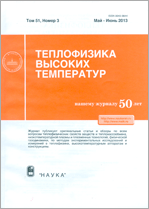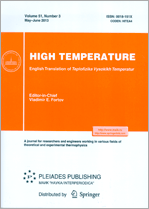|
This article is cited in 1 scientific paper (total in 1 paper)
Plasma Investigations
Gordon method for the generation of nanowires and high-temperature processes in superfluid helium
A. V. Karabulina, M. I. Kulishb, V. I. Matyushenkoc, B. M. Smirnovd, É. E. Sond, A. G. Khrapakd
a Moscow Institute of Physics and Technology
b Institute of Problems of Chemical Physics, Russian Academy of Sciences, Chernogolovka, Moscow region
c Institute of Energy Problems for Chemical Physics, Russian Academy of Sciences (Chernogolovka Branch)
d Joint Institute for High Temperatures, Russian Academy of Sciences, Moscow
Abstract:
The Gordon method for the generation of metal nanowires in superfluid helium as a result of the laser evaporation of a metal surface that is contiguous with superfluid helium has been analyzed. The cluster stage of the process, in which a beam of evaporated metal atoms is transformed into a gas of metal clusters so that further relaxation of the evaporated metal is due to radiation by metal clusters, is considered. These processes are experimentally compared for the case in which a beam of evaporated tungsten atoms is fed into superfluid helium, a vacuum, and helium gas. Since the relaxation process in this stage runs at a temperature of several thousands of kelvin in the region of the cluster presence, the radiative mechanism of cluster cooling is similar in the considered cases; however, for superfluid and normal helium, a significant contribution to the cooling rate is from the heat transfer in helium. It follows from the experiment that the next stage of evaporated metal relaxation in superfluid helium includes the division of the metal-containing region into many small regions bounded by individual vortices. Each vortex captures a large number of clusters that move to the axis of this vortex and are aggregated therein. This leads to the formation of metal nanowires with a length that is about two orders of magnitude larger than their radius. These nanowires comprise a special physical object of both fundamental and practical importance.
Received: 10.09.2019
Revised: 02.06.2020
Accepted: 14.10.2020
Citation:
A. V. Karabulin, M. I. Kulish, V. I. Matyushenko, B. M. Smirnov, É. E. Son, A. G. Khrapak, “Gordon method for the generation of nanowires and high-temperature processes in superfluid helium”, TVT, 59:3 (2021), 337–344; High Temperature, 59:2-6 (2021), 143–149
Linking options:
https://www.mathnet.ru/eng/tvt11277 https://www.mathnet.ru/eng/tvt/v59/i3/p337
|


|





 Contact us:
Contact us: Terms of Use
Terms of Use
 Registration to the website
Registration to the website Logotypes
Logotypes








 Citation in format
Citation in format 
